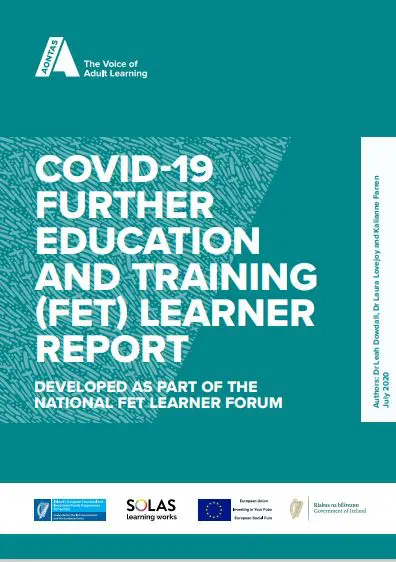The report echoes many of the issues, and supports recommendations raised in AONTAS’ recent publications on the impact of COVID-19 on adult learners, including the “COVID-19 Further Education and Training (FET) Learner Report” and the “Virtual Community Education Learner Focus Group and Learner Survey” report. These issues have also been to the fore in outputs of the Mitigating Educational Disadvantage (Including Community Education Issues) Working Group, established by the former Department of Education and Skills and chaired by AONTAS.
Research indicates that the impact of the pandemic will be felt most acutely by people from disadvantaged backgrounds and those with special educational needs
The ESRI report, along with recent domestic and international research findings, indicates that various learner cohorts (such as low-income families, lone parents, migrants, and those with a disability) have faced unique and compounding challenges during COVID-19. The report also notes that “children and young people from more disadvantaged backgrounds will return to school having suffered greater levels of ‘learning loss’ on average” (viii). This problem is also emphasised by the recent OECD background note for the G20 Framework Working Group which recognises that “individuals’ socioeconomic background plays a major role in determining health and educational outcomes over this period” (“Enhancing Equal Access to Opportunities for All in G20 Countries”, 4). AONTAS’ research findings likewise indicate that disadvantaged learner cohorts have been particularly hard-hit by the pandemic, and faced many barriers to engaging in learning.
In the AONTAS learner survey those learners with a disability in particular were found to have struggled with a lack of structure and motivation. 47% answered that they either “strongly agree” or “agree” to the statement “I struggle with a lack of structure to my day” and 39% answering similarly in response to the statement, “I struggle to find the motivation to learn.” As noted in the ESRI report, home environment also has a key part to play with learners from disadvantaged groups having less access to space and resources (6; 12). Furthermore, “overcrowding and unsatisfactory living arrangements are likely to affect individuals’ quality of life, especially when forced to live under lockdown during the pandemic” (Darmody et al., 20). In the AONTAS learner survey many learners also indicated that their home environment was not conducive to learning. They described a lack of appropriate learning spaces and ergonomic challenges. Travellers, Roma, and learners in Direct Provision were more likely to complete their work in a bed, on a sofa, or on a floor. AONTAS research also demonstrates that these learner cohorts are at greater risk of suffering with poor mental health on account of the crisis. 42% of learners with a disability indicated that they were struggling with their mental health during this crisis, compared to an overall average of 32%.
The negative implications for mental health are also noted by the ESRI and various international studies have shown an increase in depression and anxiety among adults and young people. This “was more prevalent among younger adults and females as well as those who had experienced loss of income resulting from the pandemic. Those who had direct experience of the virus (themselves or someone close to them having contracted it)” (Darmody et al., 52). AONTAS research indicates that many adult learners have been affected by the pandemic in similar ways with nearly one in ten (9.3%) survey respondents losing their job due to COVID-19 and 12% of learners indicating that they had experienced a bereavement during this period that had impacted negatively on their learning.
The ESRI study draws on examples of other recent crises, such as Hurricane Katrina in the United States, in an effort to gauge the long-term impact of the pandemic. The available data points to significant and enduring consequences for mental health and learning loss for disadvantaged groups (x; 27). Supports will need to be put in place to help minimize the negative impact of these wide-ranging challenges for learners.
COVID-19 has revealed a digital divide between learners globally (Darmody et al., 36)
Both local and international research reviewed by the ESRI highlights disparities in access to IT devices and researchers conclude that with the move to “e-learning full-time, the digital divide widens between disadvantaged and better-off schools and families” (36). In parallel, AONTAS research indicates that access to technology has been a pervasive problem for adult learners in both FET and community education, and particularly for Traveller and Roma populations. Of the learners who identified as members of the Traveller or Roma community, 52% reported not having access to a laptop to complete their coursework. 68% also indicated they relied on a mobile phone for their learning. This was higher than the overall survey population.
Broadband issues have emerged repeatedly in consultation with learners. For example, in a survey conducted by Longford Women’s Link only 47% of respondents had access to “reliable broadband” with 29% having access to broadband they did not consider reliable. As noted by the ESRI researchers “this digital divide is closely related to socioeconomic advantage or disadvantage but also has a regional dimension, and thus highlights the importance of implementing the National Broadband Plan (see Mohan et al., 2020)” (67).
The resumption of face-to-face provision is particularly important for courses which cater for more disadvantaged groups
The research review conducted by the ESRI in relation to children and young people reinstates the value of face-to-face learning, which is particularly important for “more disadvantaged groups of young people where relationships of trust between participants and staff are key in re-engaging disaffected youth” (ix). Findings from focus groups and surveys conducted by AONTAS emphasise the importance of face-to-face learning, particularly within community education, which places a premium on the tutor/learner relationship, as well as peer support. Learners in the Virtual Community Education Focus Group, for example, noted a distinction between tutors with whom they had initially established a strong connection through face-to-face learning and those whom they had first connected with online during the pandemic: “I found the tutor was supportive [when] we had built a relationship”, noted one learner.
Learners who were engaged in community education also expressed a strong desire to return to the physical learning environment, with 71% of respondents indicating that “collaborative or peer learning [was] part of their course”. Nearly 4 out of 5 learners (78%) made it clear that they “would prefer to return to my classroom as it was prior to COVID-19”. This was also a strong component for learners engaged in FET overall with a significant majority (69.6%) of learners preferring to return to the classroom as it was pre-COVID-19. The desire to return was higher among Traveller and Roma populations where 84.3% indicated a preference to return to face-to-face learning.
Research indicates opportunity to build back better
In reviewing existing research on the inequalities facing young people and families prior to, and during, the pandemic the ESRI researchers highlight a number of ways that the crisis offers fresh opportunities to create more equitable learning opportunities in Ireland. Among the recommendations outlined at the launch of the report was an increase in therapeutic supports available through education. These supports were already under pressure before COVID and will now see increased demand. Also referenced was how supports must be put in place to tackle learning loss which has disproportionately impacted disadvantaged groups negatively.
The findings support the implementation of increased “supports for youth transitions into the labour market: career guidance, investment in job-specific training, incentives to recruit apprentices, broader stimulus” for employment including wage subsidies (ESRI presentation, 22 July). This opportunity to “build back better” is corroborated by the OECD research “Building Back Better: A Sustainable, Resilient Recovery after COVID-19” and “Enhancing equal opportunities for all in G20 countries”, a background note to the G20 Framework Working Group. Drawing on the OECD findings, Lawrence Boone et al. note that “targeted employment support and screening for barriers to access opportunities can help ensure that all young people, and particularly the most disadvantaged, receive the type and intensity of employment and welfare support that they need”.
In summary, an increasing body of research indicates the need for substantial resources and sustained efforts in addressing those educational and related inequalities which have deepened and at the same time been made more visible as a result of the pandemic. AONTAS welcomes the recently announced €168 million package from Government, which includes extra supports for students, additional funding for mental health and students with disabilities, and a €15m fund to provide access to devices. We hope to see funding support for community education organisations also, as they seek to engage the most marginalised learners. When adequately resourced to do so, further, adult and community education can play a crucial role in the transition to a more inclusive and resilient Ireland.
Works cited
AONTAS. 2020. Virtual Community Education Learner Focus Group and Learner Survey. [Online]. [Accessed 24 Jul. 2020]. Available from: https://www.aontas.com/assets/resources/AONTAS-Research/Virtual%20Community%20Education%20Learner%20Focus%20Group%20and%20Learner%20Survey%20June%202020.pdf
AONTAS 2020. AONTAS COVID-19 Further Education and Training (FET) Learner Report. Available from: https://www.aontas.com/assets/resources/Learner-Work/AONTAS%20COVID-19%20Learner%20Report%20-%20Final.pdf
Boone, L., Caldera Sanchez, A., Kergozou, N. and Scarpetta, S. 2020. Building back better: enhancing equal access to opportunities for all. ECOSCOPE. [Online]. [Accessed 24 Jul. 2020]. Available from: https://oecdecoscope.blog/2020/07/21/building-back-better-enhancing-equal-access-to-opportunities-for-all/
Darmody M., Smyth E, and Russell H. 2020. The Implications of The Covid-19 Pandemic for Policy In Relation To Children And Young People: A Research Review. ESRI. [Online]. [Accessed 24 Jul. 2020]. Available from: https://www.esri.ie/system/files/publications/SUSTAT94_3.pdf
Darmody M., Smyth E, and Russell H. 2020. Presentation: The COVID-19 pandemic: Implications for policy in relation to children and young people. ESRI. [Online]. [Accessed 24 Jul. 2020]. Available from: https://www.esri.ie/sites/default/files/media/file-uploads/2020-07/SLIDES_The%20COVID-19%20pandemic%20Implications%20for%20policy%20in%20relation%20to%20children%20and%20young%20people_DARMODY.pdf
OECD. 2020. Building Back Better: A Sustainable, Resilient Recovery after COVID-19. [Online]. [Accessed 24 Jul. 2020]. Available from: https://www.oecd.org/coronavirus/policy-responses/building-back-better-a-sustainable-resilient-recovery-after-covid-19-52b869f5/
OECD. 2020. Enhancing equal opportunities for all in G20 countries, a background note to the G20 Framework Working Group. [Online]. [Accessed 24 Jul. 2020]. Available from: http://www.oecd.org/economy/Enhancing-equal-access-to-opportunities-OECD-background-note-for-G20-Framework-Working-Group-july-2020.pdf





